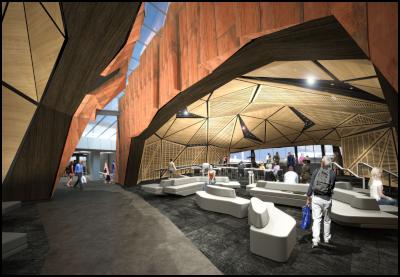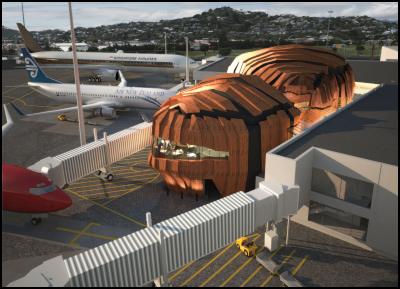19 February 2008
Wellington Airport unveils
New Zealand’s newest icon “The Rock”
Wellington International Airport today revealed the design of its international passenger terminal, which will complete the terminal’s expansion and upgrade. The building encapsulates Wellington’s individuality and creativity and will undoubtedly create a unique and memorable visitor experience.
The bold and dramatic design, affectionately tagged “The Rock”, is in contrast to the bland halls that typify most international airports. The airport’s South Coast location is represented by the inside aesthetics and outside shell of the building. Coloured fragments of glass in the roof fissure let in a warm, natural light by day and backlighting at night creates a glow which will be seen from the air.
“Our radical departure from traditional airport design worldwide is entirely deliberate. What is set to become New Zealand’s newest iconic building, The Rock combines functionality and capacity with what will be a memorable visitor experience. It’s edgy and in keeping with our Wild at Heart attitude, reflecting Wellington’s status as a vibrant and daring cultural city. With our commitment to regional tourism and further developing international services, we are creating the airport to take Wellington into the next decade," said Steven Fitzgerald, Wellington Airport CEO.

Click for big version
Two of New
Zealand’s leading design personalities have endorsed the
project’s design.
“It is incredibly inspiring to think that Wellington will have a truly iconic building at the doorstep to the city. Hooray to all involved in this highly creative development at the Wellington Airport, as this wonderfully dynamic architectural highlight will be a shining star for our city’s future.” (Richard Taylor, Weta Workshop)
“Well done to Wellington Airport for being so bold in rejecting the ordinary and embracing the extraordinary. WOW! The design of the International Terminal makes a dramatic theatrical statement; it encapsulates beautifully the personality of Wellingtonians and their surrounding environment.” (Suzie Moncrieff, World of Wearable Art)
Wellington
Mayor Kerry Prendergast said the design of the international
terminal truly reflected the uniqueness and creativity of
Wellington and Wellingtonians. “Wellington is the
Creative Capital of New Zealand. We welcome and celebrate
creativity and innovation. It’s great to see Wellington
businesses thinking outside the square and capturing the
uniqueness of our city in this way. I have no doubt this
terminal will become a talking point, not just nationally,
but internationally, once again putting Wellington on the
map. It’s fantastic and I congratulate all those
involved.” And, from Tim Cossar, Positively Wellington
Tourism CEO, “Wellington has established a reputation
for being leading-edge and innovative. Wellington
Airport’s new international passenger terminal further
confirms that reputation. Its design is eye-catching and
iconic, giving visitors a feel for Wellington’s creative
spirit, right from the moment they arrive. This is just the
sort of new development Wellington needs to keep positioning
itself competitively in domestic and international
markets.” Member for Rongotai, The Hon Annette King,
said "Wellington has consistently shown it is prepared to
take bold approaches to developing infrastructure and
amenities. This design is another dramatic example."
Functionality
The Rock element is a small proportion of the entire international terminal upgrade. The new facility will complete the immense improvement in the passenger’s intuitive journey from the departure point from the main terminal to the aircraft door. The international passenger terminal upgrade is in two stages. Stage 1, completed in December 2007, includes:
o A better defined international departure farewell area; o Improved queuing for Customs; o Enhancements to customs and MAF processing and aviation security screening (doubling processing capability); o Reconfigured and consolidated duty free shopping areas with a new duty free concessionaire; o Access to an additional international baggage belt; o Additional aerobridge and domestic gates with international swing capacity (being used to accommodate Pacific Blue domestic services and increased services from other airlines). Stage 2 is expected to be completed at the end of 2009, will involve a number of components which are significant projects in their own right: o Expanded and redesigned international departure lounge building with extra lounge seating for 660 seats; o Improved waiting and queuing areas to gates; o Additional toilets and a new café; o Another aerobridge (bringing the total number from 6 to 8 available to international aircraft) o New fuel hydrants and apron works.
Design efficiency and environmental sustainability As well as creating a memorable visitor experience, and optimum functionality, the architectural brief required planning efficiency and economy in building materials and construction. The construction itself uses standardised and economical building components in a creative way. Examples include: o incorporation of plywood and fibre-cement in the carcass of the building o windows are aluminium with plywood reveals Meticulus planning has gone into recycling, refurbishing and salvaging. Examples include: o reuse of mechanical plant o refurbishment of lifts and toilets o reuse and salvaging of ceiling tiles, security cameras, PA, lights, phones and gate signs o reupholstering of lounge seats o refurbishing of aerobridges o retaining existing shear walls which would otherwise be expensive to remove
Strong Environmentally Design features include: o ramps instead of escalators or lifts where possible o energy saving features such as double and laminated glazing, sun protection louvres, natural daylight via skylights, low flow bathroom fittings
o environmental range paint specifications o low velocity mechanical thermal plant
Passenger growth
Wellington Airport’s announcement is consistent with the current trend toward better New Zealand airport infrastructure and the resulting capacity growth. International passengers grew by 5.1% in the last 12 months compared to the previous 12 months (Jan to Jan), a trend that is expected to continue. The terminal expansion will address current passenger congestion and prepare for future growth by doubling international processing capacity to 1000 passengers/hour.
Planning efficiencies and future flexibility have been accommodated in the design to allow for growth: o baggage swing belts and operable walls with domestic and international capability o additional AVSEC screening and customs facilities o spare mezzanine space within the lounge for additional seating or further amenities
Importantly, the aerobridges can accommodate existing trans-Tasman aircraft as well as the B787, in fit with Wellington Airport’s strategy of encouraging airlines to provide long haul services.
Cost recovery
The new passenger terminal is expected to cost $39 million. The airport and airlines discussed the allocation of aeronautical income towards this investment during pricing consulations concluded in June 2007. Aeoronautical charges were marginally increased in July 2007 by 2.85% (around 30c/pax) for the next 5 years to fund the two-staged terminal upgrade ($53m) and other aeronautical projects such as the runway end safety areas ($31m). There will be no rise in the international departure fee. Wellington architects Studio Pacific Architecture in association with Warren and Mahoney have designed both stages of the terminal development.
ENDS





 NIWA: Flooding From Underneath - New Tool Reveals Shallow Groundwater Elevations
NIWA: Flooding From Underneath - New Tool Reveals Shallow Groundwater Elevations Commerce Commission: Commission Concludes Auckland Airport Over-charging By $190 Million
Commerce Commission: Commission Concludes Auckland Airport Over-charging By $190 Million The Future Is Rail: Ferry Decision - Common Sense Prevails
The Future Is Rail: Ferry Decision - Common Sense Prevails Aotearoa Food Rescue Alliance: Grocery Market Reform Must Include Mandatory Food Rescue Partnerships
Aotearoa Food Rescue Alliance: Grocery Market Reform Must Include Mandatory Food Rescue Partnerships Hugh Grant: Zero Trust Security - A Buzzword Or The Ultimate Protection?
Hugh Grant: Zero Trust Security - A Buzzword Or The Ultimate Protection? Bill Bennett: Comcom revisits fibre rules as competition intensifies
Bill Bennett: Comcom revisits fibre rules as competition intensifies



